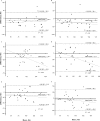Reliability and Validity of the Belt-Stabilized Handheld Dynamometer in Hip- and Knee-Strength Tests
- PMID: 28787180
- PMCID: PMC5634229
- DOI: 10.4085/1062-6050-52.6.04
Reliability and Validity of the Belt-Stabilized Handheld Dynamometer in Hip- and Knee-Strength Tests
Abstract
Context: The belt-stabilized handheld dynamometer (HHD) has been used to assess the strength of knee- and hip-muscle groups. However, few researchers have examined its reliability and validity for assessing the strength of these muscles.
Objective: To evaluate the intra-examiner reliability of the belt-stabilized HHD and its validity and agreement with the isokinetic dynamometer for assessing the strength of knee- and hip-muscle groups.
Design: Cross-sectional study.
Setting: University laboratory.
Patients or other participants: We evaluated 26 healthy participants (13 men, 13 women; age = 23.5 ± 2.8 years, height = 1.7 ± 0.1 m, mass = 68.6 ± 12.4 kg) in 2 sessions using the belt-stabilized HHD and an isokinetic dynamometer for maximum strength of the hip adductors, abductors, flexors, extensors, internal rotators, and external rotators and the knee flexors and extensors.
Main outcome measure(s): We used reliability values provided by the intraclass correlation coefficient (2,3), standard error of measurement (SEM and percentage SEM), and minimal detectable change; correlation values comparing the belt-stabilized HHD and the isokinetic instrument using the Pearson correlation coefficient (r); and the mean difference in values comparing the 2 instruments using the Bland-Altman method.
Results: The intrarater HHD reliability was excellent for most measurements (range = 0.80-0.96; SEM = 1.3-5.3 kilograms of force or 4.8-18.9 Nm, percentage SEM = 7.0%-22.0%, minimal detectable change = 3.6-18.8 kilograms of force or 13.2-52.4 Nm) and was moderate only for bilateral knee flexion and left hip internal rotation (intraclass correlation coefficient [2,3] = 0.62-0.66 and 0.70, respectively). Correlation with the isokinetic dynamometer was moderate to high (r = 0.60-0.90), but the absolute values did not demonstrate concordance between results using the Bland-Altman method.
Conclusions: The belt-stabilized HHD measurements were reliable, and although they did not agree with those from the isokinetic dynamometer, the values were correlated for the hip- and knee-muscle groups.
Keywords: lower extremity; muscle strength; reproducibility of results.
Figures





References
-
- Gadea F, Monnot D, Quelard B, et al. . Knee pain after anterior cruciate ligament reconstruction: evaluation of a rehabilitation protocol. Eur J Orthop Surg Traumatol. 2014; 24 5: 789– 795. - PubMed
-
- Lankhorst NE, Bierma-Zeinstra SMA, van Middelkoop M. . Risk factors for patellofemoral pain syndrome: a systematic review. J Orthop Sports Phys Ther. 2012; 42 2: 81– 94. - PubMed
Publication types
MeSH terms
LinkOut - more resources
Full Text Sources
Other Literature Sources
Medical

